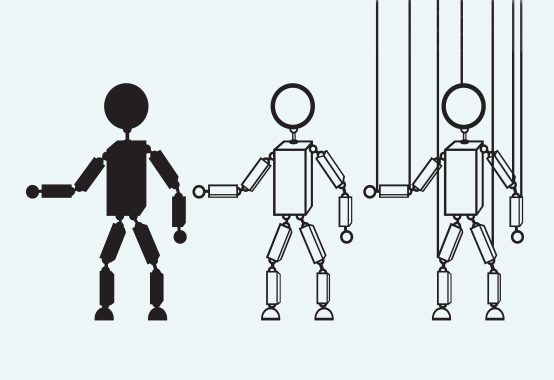Who Pulls John Gray’s Strings?

John Gray, emeritus professor of European Thought at the London School of Economics, is an enigma. He began his intellectual life on the left but moved right in the late 1970s, becoming a fan of Nobel Prize-winning free-market economist F.A. Hayek. Gray’s libertarianism was tempered, however, by studying British philosopher Michael Oakeshott’s critique of “rationalism in politics.” During the 1990s, Gray was associated with New Labour—the center-left ideology that brought Tony Blair to power in Westminster—and he became a prominent critic of global capitalism with his 1998 book False Dawn.
Recently he appears to have embraced something of a nihilistic stoicism, whose spirit suffuses The Soul of the Marionette. In these pages he undertakes a sort of jazz improvisation on the theme of human freedom, surveying an omnium-gatherum of earlier writers’ and cultures’ thoughts on the topic from the point of view of a “freedom-skeptic.”
Gray sees the modern, supposedly secular belief in human freedom as a creed that will not admit its character: “Throughout much of the world … the Gnostic faith that knowledge can give humans a freedom that no other creature can possess has become the predominant religion.” Gray finds the Gnostic frame of mind even among “hard-headed” scientists:
The crystallographer J. D. Bernal … envisioned ‘an erasure of individuality and mortality’ in which human beings would cease to be distinct physical entities … ‘consciousness itself might end or vanish … becoming masses of atoms in space communicating by radiation, and ultimately perhaps resolving itself entirely into light.’
In another vignette of a thinker he finds relevant to his inquiry, Gray discusses the philosophy of the 19th-century Italian writer Giacomo Leopardi, most famous for penning the classic poem “L’Infinito.” Leopardi was a staunch materialist who nevertheless found religion to be a necessary illusion. He understood Christianity as an essential response to the rise of skepticism in Greco-Roman culture; in Leopardi’s view, “What was destroying the [ancient] world was the lack of illusion.” Christianity had now gone into decline, but this was not to be celebrated; as Gray quotes Leopardi, “There is no doubt that the progress of reason and the extinction of illusions produce barbarism.” What was arising from the “secular creeds” of his time was only “the militant evangelism of Christianity in a more dangerous form.”
Gray finds Edgar Allan Poe’s vision of a world where “human reason could never grasp the nature of things” congenial and devotes several pages to the American poet. He also takes up the trope of the golem as evinced in Mary Shelley’s Frankenstein, declaring “Humans have too little self-knowledge to be able to fashion a higher version of themselves”—a view on the surface at odds with his later proclamations about the coming age of artificial intelligence.
Continuing his odyssey, Gray arrives at the isle—or rather, planet—of Stanislav Lem’s novel Solaris (which was made into a 2002 movie starring George Clooney). It features a water-covered world involved in “ontological auto-metamorphosis.” According to the “heretical” scientific theories its discovery spawned, the planet has a “sentient ocean”: Lem was prefiguring something like the Gaia hypothesis of James Lovelock that Gray has invoked favorably here and in earlier works.
Gray also takes interest in the work of renowned American science fiction writer Philip K. Dick, who wrote a series of novels that advanced one of the most compelling paranoid metaphysics of our time. Gray notes that Dick is an archetypal Gnostic, as shown by lines like “Behind the counterfeit universe lies God … it is not man who is estranged from God; it is God who is estranged from God.” For Dick, it is unlikely that anyone can ever penetrate to a “true” reality through the veil of illusion: “were we to penetrate [that veil] for any reason, this strange, veil-like dream would reinstate itself retroactively, in terms of our perceptions and in terms of our memory. The mutual dreaming would resume as before…”
Dick ultimately concluded that the flawed world he lived in was just a costume concealing the good world that is the true reality. But if this is so, Gray asks, how did this veil come into being? If an all-powerful God created it, then He must have wanted the veil to exist. But if it is the creation of some sub-deity, a Demiurge, then the “top” God is not all-powerful since he could not prevent the veil from coming into being. Of course, this is the ancient problem of theodicy restated in different terms, but it is to Gray’s credit that he recognizes it at play in Dick’s oeuvre. 
And as Gray notes, Dick was a very modern Gnostic in that he incorporated into his philosophy the idea of an evolution towards higher states of being taking place over time. In fact, it is “not least when it is intensely hostile to religion” that modern thought most embraces tales of the historical redemption of humanity. Gray argues that “All modern philosophies in which history is seen as a process of human emancipation … are garbled versions of [the] Christian narrative.”
The next section of the book, called “In the puppet theatre,” begins with a look at the Aztec penchant for mass ritual killing. He quotes anthropologist Inga Clendinnen at length on the gruesome nature of the practice, including descriptions like: “On high occasions warriors carrying gourds of human blood or wearing the dripping skins of their captives ran through the streets … the flesh of their victims seethed in domestic cooking pots; human thighbones, scraped and dried, were set up in the courtyard of the households…”
Gray contends the Aztecs were superior to modern state-based killers in that their victims were not “seen as less than human.” But only two pages later he claims, “In the ritual killings, nothing was left of human pride. If they were warriors, the victims were denied any status they had in society” and were “trussed like deer,” which certainly makes it sound as though they were seen as less than human.
In any case, Gray views Aztec society as a lesson in the inevitability of human violence. We tamp it down in one place, only to see it pop back up in another. He is skeptical of statistics that seem to show a long-term decline in violence. He cites violence-caused famines and epidemics, deaths in labor camps, the gigantic U.S. prison population, the revival of torture in the most “civilized” societies, and other modern atrocities to call these figures into doubt. And he sees the false sense that we have overcome this human tendency to violence in “enlightened” Western societies as connected to our arrogant approach in dealing with “unenlightened” societies:
By intervening in societies of which they know nothing, western elites are advancing a future they believe is prefigured in themselves—a new world based on freedom, democracy and human rights. The results are clear—failed states, zones of anarchy and new and worse tyrannies; but in order that they may see themselves as world-changing figures, our leaders have chosen not to see what they have done.
Gray turns his attention to French Marxist Guy Debord, finding “nothing of interest” in his standard Marxist schema but noting that Debord was ahead of his time in analyzing celebrity. With work no longer giving life meaning, it is necessary that our “culture of celebrity” offers everyone “fifteen minutes of fame” to reconcile us to the “boredom of the rest of [our] lives.” He quotes Debord on the rising social importance of “media status”: “Where ‘media status’ has acquired infinitely more importance than the value of anything one might actually be capable of doing, it is normal for this status to be readily transferable…”
This quote gets at the heart of why in 2015 we see headline coverage of a dispute between singer Elton John and fashion designers Domenico Dolce and Stefano Gabbana on the proper form for the family. Are fashion designers or pop songwriters experts on child development or the ethics of the family? If not, why is anyone paying any attention to this feud? Well, because they are celebrities with high “media status,” and that status is “readily transferable” to any other field whatsoever.
Bored modern individuals are also rootless. Gray sees the rise of the surveillance state as tied to that condition:
When people are locked into local communities they are subject to continuous informal monitoring of their behaviour. Modern individualism tends to condemn these communities because they repress personal autonomy … The informal controls on behavior that exist in a world of many communities are unworkable in a world of highly mobile individuals, so … near-ubiquitous technological monitoring is a consequence of the decline of cohesive societies that has occurred alongside the rising demand for individual freedom.
As The Soul of the Marionette draws to a close, Gray heads off into a sort of nature mysticism where his thinking is—to me, at least—at its most obscure. Considering climate change, he claims: “Whatever is done now, human expansion has triggered a shift that will persist for thousands of years. A sign of the planet healing itself, climate change will continue regardless of its impact on humankind.” But how does Gray know climate change is a “sign of the planet healing itself,” rather than, say, a sign of its decline or something the planet itself is completely indifferent to?
Gray’s gloomy vision seeps through in his prognosis for the human race too: “However it ends, the Anthropocene”—the epoch of humanity’s rule—“will be brief.” Again, I wonder how Gray knows this? Here he appears as the anti-Hegel, somehow sussing out the future of man much like the German philosopher, but from pessimistic rather than optimistic presuppositions.
Although Gray is an atheist and a materialist of some sort or another, he correctly understands what science can and can’t tell us:
Nothing carries so much authority today as science, but there is actually no such thing as ‘the scientific world-view.’ Science is a method of inquiry, not a view of the world. Knowledge is growing at accelerating speed; but no advance in science will tell us whether materialism is true or false, or whether humans possess free will.
He also gets at the deep meaning behind religious stories: “being divided from yourself goes with being self-aware. This is the truth in the Genesis myth: the Fall is not an event at the beginning of history, but the intrinsic condition of self-conscious beings.” (Albert Camus, like Gray a nonbeliever, understood this very well: see his novel The Fall.)
Yet there is a problem with the coherence of Gray’s outlook. He urges us to adopt a stoical attitude towards our predicament as marionettes. But if we are free to choose our attitude, why are we not also free to make other choices about our lives? Then again, perhaps Gray isn’t really to blame for this incoherence: it could be that some unknown puppeteer, pulling on Gray’s strings, made him write this book.
Gene Callahan teaches computer science at St. Joseph’s College in Brooklyn and is the author of Oakeshott on Rome and America.